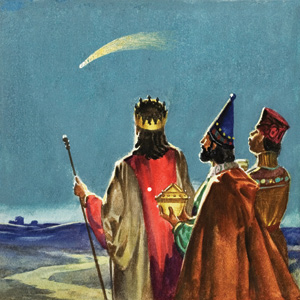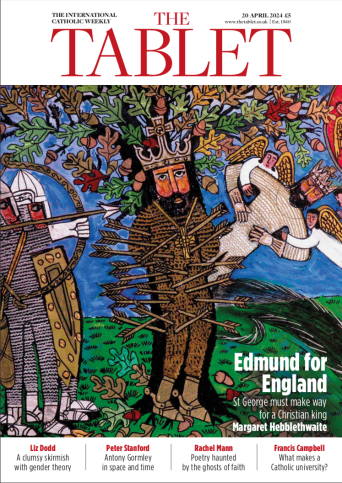Bethlehem’s Church of the Nativity has a silver star marking the spot where Jesus is said to have been born. The Star of Bethlehem vies with tinselled angels to top our Christmas trees. It is embossed on countless greeting cards and it has come to be one of the great symbols of the Nativity story.
For the gospel writer Matthew, the appearance of the star at the time of Jesus’ birth and the way it guided the Magi to where he lay is an impressive confirmation of Jesus’ messianic status. If it did occur, it would indeed be that, and it would also authenticate Matthew’s reliability as a historically accurate biographer.
Scarce wonder, then, that a fierce debate rages over what the star might have been. Was it a planet like Jupiter, a supernova (exploding star), a couple of meteors, or something else? Perhaps it was a miraculous body and therefore beyond scientific scrutiny? Or should it simply be regarded as mythical?
The biographical genre of Matthew, the compatibility of Matthew’s narrative with Roman historian Josephus’ account of Herod’s final years, and the fact that it features astrologers (despised by Jews and Christians and so unlikely to be the protagonists in a fabricated story) all support the historicity of the account.
That the star was an astronomical body is strongly suggested by the words “star” (aster) and “rising” (Matthew 2:2, 9) and by its characterisation as a bright and obvious celestial body by Ignatius (early second century). In Matthew’s account, the Magi first saw the star more than a year before Herod’s slaughter of Bethlehem’s infants.
Many months afterwards, it had a “rising” in the eastern sky that made a deep impression on the Magi. Soon after, the star was in the southern evening sky to usher the Eastern astrologers to Bethlehem, before it stood over the house, pinpointing it as the place where the Messiah lay. This information, it seems to me, eliminates all of the hypotheses offered to explain the star except one – that it was a comet.
Origen, writing in the third century, made a detailed case for this interpretation. At the turn of the second century, Ignatius’ description of the star (“a brightness beyond all the stars”; “its newness caused astonishment”; “unlike anything else [in the heavens]”) is very consistent with a bright comet. What the Protevangelium of James (mid second century) records concerning the star (“an immense star shining among these stars and causing them to become dim”) is similarly compatible with sightings of a large, bright comet.
The case for the star being a comet – a dark, icy dirtball that develops a head (“coma”) and a tail (or two) as it approaches the Sun – is formidable. Its movement over a couple of months from the eastern morning sky, where it “rose,” to the southern evening sky, where it was at the climax of the Magi’s journey, makes such an explanation compelling.
The star’s sudden appearance and strangely long period of visibility is strikingly consistent with a large long-period comet. In our own time, the comet Hale-Bopp remained visible to the naked eye for 18 months in 1996–97.
That the Bethlehem star’s “rising” was surprising and extraordinary strongly suggests a comet making a close pass by the Sun. The “risings” of other celestial bodies – from their first appearance over the horizon after a period of invisibility due to proximity to the Sun – were predictable and visually unimpressive. But comets can be unpredictable, even astonishing; they are at their most active, even hyperactive, when they’re closest to the Sun.
As for the star’s “going before” the Magi and “standing over” a particular location, ancient writers describe comets in precisely these terms. The Greek historian Diodorus Siculus relates how a comet “went before and led” Timoleon as he sailed westwards to the boot of Italy on his way to Sicily. Josephus tells of how a comet “stood over” Jerusalem in the period prior to its destruction, its sword-like appearance heralding its impending doom. A comet, its tail streaming upwards, might well be the star pinpointing where Jesus lay.
For the ancients, comets were often bad omens: perhaps this might be why Herod reacted as he did to the Magi’s arrival. But they might also herald good news. In 135–134 BC and 120–119 BC, comets were seen as announcing the greatness of Mithridates VI Eupator on the occasion of his birth and coronation, respectively.
A great comet in 44 BC was embraced as a good omen, signalling Julius Caesar’s reception among the gods, and it was privately interpreted by Octavian (Caesar Augustus) as an auspicious omen for his reign.
Remarkably, Balaam’s oracle concerning the Messiah’s appearance in Numbers 24:17 speaks of him in terms that are distinctly cometary – he will be a “sceptre” (Revised English Bible: “comet”) and a “star” that “shall rise” – alluding to the celestial phenomenon that would announce his birth. Many Matthean scholars have rightly detected an allusion to Balaam’s oracle in Matthew 2:2’s “we observed his star at its rising”. Early Christians such as Justin Martyr, Irenaeus, and Origen also regarded the star as a fulfilment of Numbers 24:17.
The Magi discerned a lot of information from the star – that someone had been born, that he was a king, indeed the King of the Jews, and that he was worthy of worship. Through their movements within and among the constellations, comets were seen as conveying significant and complex messages to suitably educated observers. Babylonian astronomers read deep meanings into a comet’s first appearance and its “rising”. It is to these two occasions in the star’s “career” that Matthew makes explicit reference.
So which comet might it have been? Halley’s Comet appeared in 12 BC but that would have the Magi arriving six years too early. In addition, it was only visible for 56 days, never had a “rising” and did not appear in the southern sky. What of the comet recorded by the Chinese in 5 BC? Again, no, because it was only observable for 70 days and did not “rise”.
Accounts of the vast majority of comets from the period of Christ’s birth are lost to history. Of those that remain, half are in surviving Chinese records and half are in scattered references in Greco-Roman literature. The surviving Chinese records were preserved because of their perceived astrological and/or ideological significance. The occasional Greco-Roman references to comets reveal that great comets are among the many comets absent from the surviving Chinese records. If Josephus hadn’t perceived in the year-long comet that stood over Jerusalem an omen of Jerusalem’s judgement, that comet would have been lost to history.
Likewise, had the early Christians not regarded the Christ comet as a divinely sent sign marking the Messiah’s birth and auguring his future greatness, this magnificent comet too would have been lost to history. Regrettably we have no surviving Babylonian records of comets after 87 BC. But what we have in Matthew 2:1-18 is, it seems to me, indirect evidence of a Babylonian comet record.
The case for the Star of Bethlehem being a great comet in the mould of Hale-Bopp is impressive. But the really intriguing question is this: what was it about the Christ comet that persuaded the Magi to cross an inhospitable desert in search of the Jewish Messiah?
Colin Nicholl’s book The Great Christ Comet: revealing the true star of Bethlehem is published by Crossway Books.
17 December 2015, The Tablet
Light in the East
The Christ comet
Edmund for England
 Loading ...
Loading ...
Get Instant Access
Subscribe to The Tablet for just £7.99
Subscribe today to take advantage of our introductory offers and enjoy 30 days' access for just £7.99





What do you think?
You can post as a subscriber user...
User Comments (0)